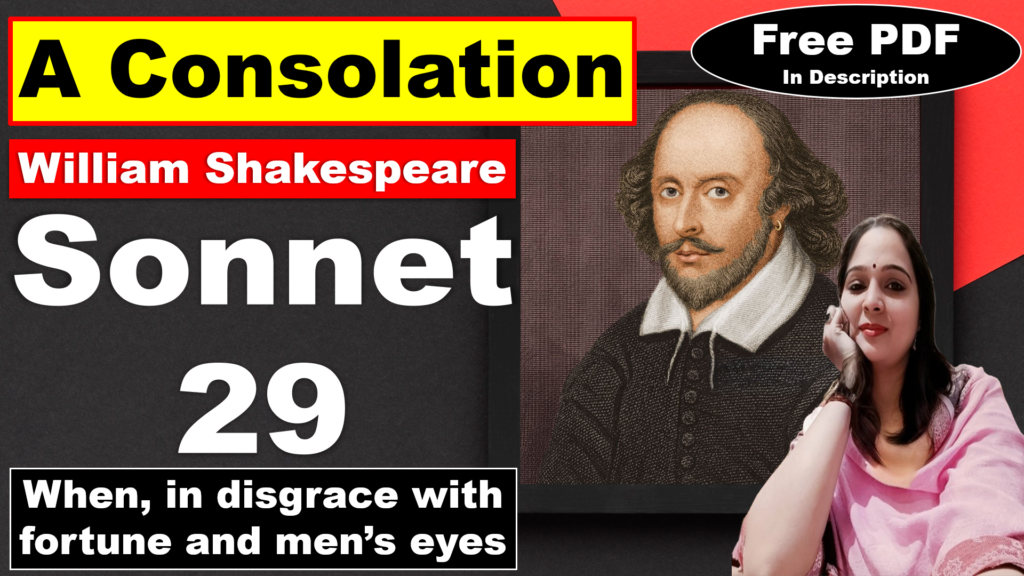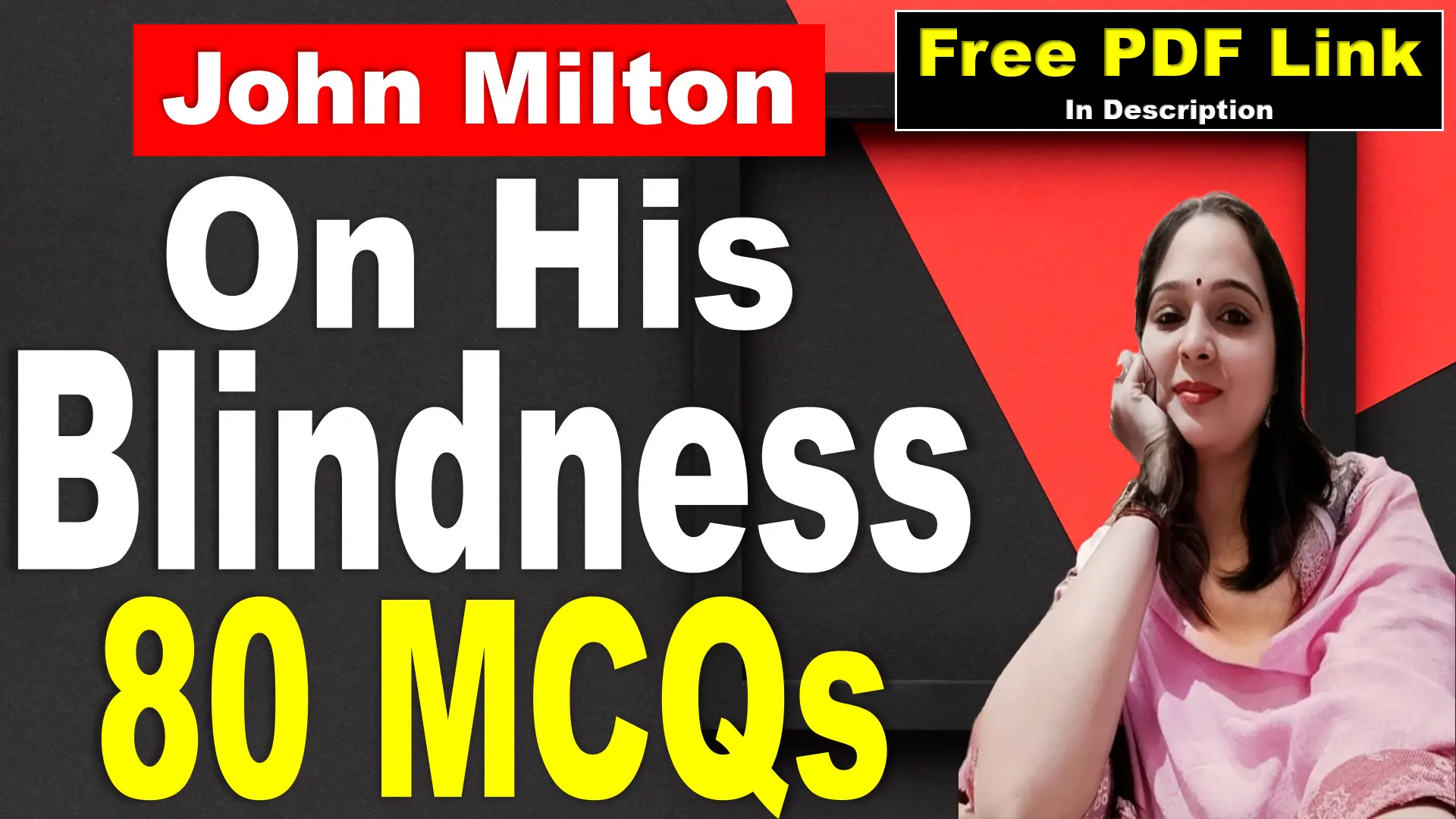
Sonnet 29 by Willian Shakespeare Questions Answers
Very Short Answer Questions
Who is the author of Sonnet 29?
William Shakespeare
What is the form of Sonnet 29?
It’s a Shakespearean sonnet.
Who is the speaker in Sonnet 29?
The speaker is a character who feels outcast and in disgrace.
What is the setting of Sonnet 29?
The setting isn’t specified, but the speaker is in a state of despair and self-loathing.
What is the theme of Sonnet 29?
The power of love and memory to bring hope and happiness.
What is the plot of Sonnet 29?
The speaker expresses their unhappiness, then their mood lifts when they think of a loved one.
What is the tone of Sonnet 29?
The tone shifts from despairing and self-pitying to joyful and content.
What is the style of Sonnet 29?
The style is characterized by rich imagery, metaphor, and tightly woven logic.
What is the message of Sonnet 29?
Love and the memory of a loved one can bring happiness and contentment.
What is the structure of Sonnet 29?
It’s composed of three quatrains and a final couplet.
What is the rhyme scheme of Sonnet 29?
The rhyme scheme is ABABCDCDEFEFGG.
What does the speaker wish in Sonnet 29?
The speaker wishes they were more like others who seem happier and more successful.
What changes the speaker’s mood in Sonnet 29?
Thinking of a loved one lifts the speaker’s mood.
What metaphor does Shakespeare use in Sonnet 29?
He uses the metaphor of a lark rising at dawn to describe the speaker’s mood lifting.
How does the speaker feel after thinking of their loved one in Sonnet 29?
The speaker feels happy and content, to the point where they wouldn’t change their state even with kings.
What does the speaker trouble in Sonnet 29?
The speaker troubles deaf heaven with their bootless cries.
What does the speaker look upon in Sonnet 29?
The speaker looks upon themselves and curses their fate.
What does the speaker desire in Sonnet 29?
The speaker desires this man’s art and that man’s scope.
What does the speaker scorn in Sonnet 29?
The speaker scorns to change their state with kings.
What does the speaker sing at in Sonnet 29?
The speaker sings hymns at heaven’s gate.
What is the speaker’s state of mind at the beginning of the poem?
Downcast, sorrowful, and filled with self-pity.
What does the speaker envy about others?
Their hope, success, friendships, talents, and abilities.
To what does the speaker compare his transformation?
To the cheerful song of a lark at dawn.
How does the speaker view his love?
As a source of immense wealth and happiness, surpassing any material possessions.
What is the significance of the lark image?
It symbolizes the speaker’s renewed spirit and joy.
What does the comparison to kings suggest?
That the speaker’s love is more precious than any earthly wealth or power.
What is the significance of the word “scorn” in the final line?
It emphasizes the speaker’s deep appreciation for his love and his refusal to trade it for anything else.
Short Answer Questions
1. Describe the speaker’s emotional state at the beginning of the poem.
The speaker is overwhelmed with despair and self-pity, lamenting his outcast state and feeling unheard by heaven. He envies the hope, success, and relationships of others, finding himself dissatisfied even with the things he once enjoyed.
2. How does the speaker’s perception of his loved one impact his outlook?
The memory of his loved one acts as a beacon of hope, transforming his despondent mood into one of upliftment and gratitude. The speaker compares his transformation to the joyful song of a lark, symbolizing his newfound lightness and optimism.
3. What is the significance of the lark imagery in the poem?
The lark, known for its cheerful and uplifting song, represents the speaker’s newfound happiness and resilience. It symbolizes the transformative power of love, which can elevate us from the depths of despair to heights of joy.
4. How does the speaker’s love for his loved one contrast with his initial self-perception?
The speaker’s love for his beloved becomes a source of immense wealth and happiness, surpassing any material possessions or external validation. It is this love that dispels his self-doubt and restores his sense of worth.
5. What is the central theme of Sonnet 29?
Sonnet 29 powerfully explores the transformative power of love, demonstrating its ability to illuminate our path even in the darkest of times. The speaker’s journey from despair to hope serves as a testament to love’s enduring and transformative nature.
6. How does the poem’s tone evolve throughout the lines?
The poem’s tone initially reflects the speaker’s melancholic and self-deprecating state, painting a bleak picture of his outcast existence. However, as the speaker’s thoughts turn to his loved one, the tone shifts to one of hope, upliftment, and gratitude.
7. What is the significance of the contrast between the speaker’s state at the beginning and end of the poem?
The contrast between the speaker’s initial despair and his final state of contentment highlights the transformative power of love. It demonstrates that even in the face of adversity, love can provide strength, solace, and a sense of purpose.
8. What does the speaker’s declaration in the final line reveal about his love?
The speaker’s assertion that he would not exchange his state for that of a king underscores the profound value he places on his love. It suggests that his love is more precious than any earthly wealth or power, reaffirming the poem’s central theme.
9. What is the role of memory in the poem’s narrative?
The memory of the speaker’s loved one serves as a catalyst for his transformation. It acts as a beacon of hope, reminding him of the beauty and connection that exist in his life. This memory rekindles his faith in himself and the world around him.
10. How does the poem’s conclusion leave the reader?
The poem’s conclusion leaves the reader with a sense of hope and affirmation. The speaker’s declaration of love’s enduring power serves as a reminder that even in the face of challenges, love can provide strength, solace, and a sense of purpose.





